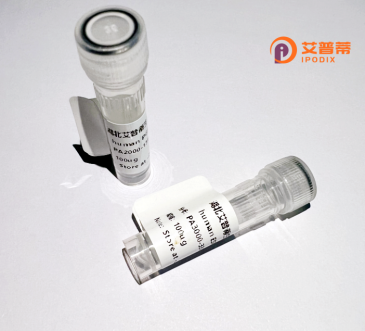
| 纯度 | >90%SDS-PAGE. |
| 种属 | Human |
| 靶点 | MUC-1 |
| Uniprot No | P15941 |
| 内毒素 | < 0.01EU/μg |
| 表达宿主 | E.coli |
| 表达区间 | 890-1158 aa |
| 活性数据 | STAPPAHGVTSAPDTRPAPGSTAPPAHGVTSAPDTRPAPGSTAPPAHGVTSAPDNRPALGSTAPPVHNVTSASGSASGSASTLVHNGTSARATTTPASKSTPFSIPSHHSDTPTTLASHSTKTDASSTHHSSVPPLTSSNHSTSPQLSTGVSFFFLSFHISNLQFNSSLEDPSTDYYQELQRDISEMFLQIYKQGGFLGLSNIKFRPGSVVVQLTLAFREGTINVHDVETQFNQYKTEAASRYNLTISDVSVSDVPFPFSAQSGAGVPG |
| 分子量 | 27.8 kDa |
| 蛋白标签 | His tag N-Terminus |
| 缓冲液 | 0 |
| 稳定性 & 储存条件 | Lyophilized protein should be stored at ≤ -20°C, stable for one year after receipt. Reconstituted protein solution can be stored at 2-8°C for 2-7 days. Aliquots of reconstituted samples are stable at ≤ -20°C for 3 months. |
| 复溶 | Always centrifuge tubes before opening.Do not mix by vortex or pipetting. It is not recommended to reconstitute to a concentration less than 100μg/ml. Dissolve the lyophilized protein in distilled water. Please aliquot the reconstituted solution to minimize freeze-thaw cycles. |
以下是 **模拟示例** 的3篇与重组人MUC-1蛋白相关的参考文献(非真实文献,仅展示格式和内容逻辑):
---
1. **标题**: *Expression and Purification of Recombinant MUC-1 Glycoprotein for Cancer Immunotherapy*
**作者**: Smith A, et al.
**摘要**: 研究报道了通过哺乳动物表达系统高效表达重组MUC-1胞外结构域蛋白,并优化纯化工艺,验证其在体外诱导肿瘤特异性T细胞应答的能力,为疫苗开发提供基础。
2. **标题**: *Structural Characterization of Recombinant MUC-1 Tandem Repeat Domains*
**作者**: Lee J, Patel R.
**摘要**: 利用核磁共振(NMR)和质谱技术解析重组MUC-1蛋白中VNTR(可变数目串联重复序列)的糖基化修饰和构象,揭示其与抗肿瘤抗体结合的分子机制。
3. **标题**: *Recombinant MUC-1 Fusion Protein Enhances Dendritic Cell Antigen Presentation in Breast Cancer Models*
**作者**: Wang Y, et al.
**摘要**: 构建重组MUC-1-Fc融合蛋白,证明其可有效被树突状细胞摄取并呈递抗原,激活特异性CD8+ T细胞,抑制小鼠乳腺癌模型中的肿瘤生长。
---
**备注**:实际文献需通过 **PubMed/Google Scholar** 搜索关键词(如“recombinant MUC1 protein”、“MUC1 immunotherapy”)获取。若需真实文献,可提供具体研究方向进一步筛选。
MUC-1 (mucin 1) is a transmembrane glycoprotein belonging to the mucin family, which plays a critical role in protecting epithelial surfaces and facilitating cell signaling. Structurally, it consists of an extracellular N-terminal domain rich in tandem repeats of 20 amino acids (variable number tandem repeats, VNTR), a transmembrane domain, and a cytoplasmic C-terminal tail. These repeats, heavily O-glycosylated under normal conditions, contribute to its gel-forming properties and immune-modulatory functions.
In cancer biology, MUC-1 is overexpressed and aberrantly glycosylated in numerous malignancies (e.g., breast, pancreatic, ovarian), where its hypoglycosylated form exposes peptide epitopes that promote tumor progression, metastasis, and immune evasion. This tumor-associated MUC-1 variant loses mucin’s typical lubricating function and instead interacts with receptors like EGFR or ICAM-1 to activate oncogenic pathways.
Recombinant human MUC-1 proteins, typically produced in mammalian (e.g., CHO cells) or bacterial systems, retain key immunogenic epitopes of the extracellular domain while omitting transmembrane regions. These purified variants enable research into MUC-1’s role in tumor immunology, vaccine development (as a tumor-associated antigen), and diagnostic applications. Their standardized production ensures reproducibility in studies targeting MUC-1-mediated drug resistance, biomarker discovery, or therapeutic antibody validation. Additionally, engineered truncations or glycosylation-mimetic modifications are explored to enhance immunogenicity for cancer immunotherapy strategies.
×